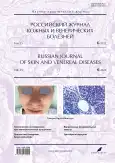Изучение эффективности и переносимости ингибитора IL-17А у пациентов с вульгарным псориазом
- Авторы: Олисова О.Ю.1, Никурадзе В.О.1, Грекова Е.В.1
-
Учреждения:
- Первый Московский государственный медицинский университет имени И.М. Сеченова (Сеченовский Университет)
- Выпуск: Том 25, № 6 (2022)
- Страницы: 71-81
- Раздел: ДЕРМАТОЛОГИЯ
- URL: https://journals.rcsi.science/1560-9588/article/view/132588
- DOI: https://doi.org/10.17816/dv114870
- ID: 132588
Цитировать
Аннотация
Обоснование. Основными векторами терапии псориаза являются подавление пролиферативной активности кератиноцитов, нормализация их дифференцировки, нейтрализация иммунного воспаления в дерме и нормализация баланса цитокинов.
Цель исследования ― изучение эффективности и переносимости ингибитора IL-17A (секукинумаб) в виде монотерапии и в сочетании с метотрексатом у больных вульгарным псориазом средней и тяжёлой степени.
Материал и методы. Под наблюдением находилось 50 больных вульгарным псориазом. Оценка степени тяжести псориаза производилась по индексу распространённости и тяжести псориаза (Psoriasis Area and Severity Index, PASI). С целью изучения качества жизни больных псориазом была использована русскоязычная версия дерматологического индекса качества жизни (ДИКЖ). Оценку выраженности зуда и его воздействия на повседневную жизнь пациентов проводили по опроснику Пруриндекс. Для определения поражения ногтевых пластинок кистей и стоп при псориазе использовали индекс NAPSI (Nail Psoriasis Severity Index). В ходе проводимой терапии в каждой из групп определяли уровни показателей PASI, ДИКЖ и Пруриндекс до лечения, на 4, 12 и 24-й неделе, NAPSI ― на 0-й и 24-й неделе.
Результаты. Все пациенты были разделены на две группы рандомизированным методом. Первая группа включала 25 пациентов возрастной категории 55 (30–67) лет со средней и тяжёлой степенью течения заболевания, которые получали терапию секукинумабом в дозе 300 мг подкожно. Вторая группа состояла из 25 пациентов в возрасте 56 (34–69) лет со средней и тяжёлой степенью заболевания, получавших терапию секукинумабом после инициации (300 мг) по 150 мг подкожно в комбинации с метотрексатом по 15 мг внутримышечно в течение 24 недель. Спустя 24 недели лечения у пациентов первой группы в результате монотерапии секукинумабом было достигнуто PASI 90 в 69% случаев, PASI 100 ― в 31%; у пациентов второй группы (секукинумаб + метотрексат) ― в 68 и 32% соответственно. У 87,3% больных обеих групп удалось сохранить клиническую ремиссию (PASI ≥90) на протяжении года. В ходе терапии у пациентов первой группы отмечалось снижение показателей ДИКЖ с 25,6±3,7 до 3,5±3,1 (p <0,01), во второй группе ― с 23,3±3,7 до 3,1±2,6.
Заключение. Лечение пациентов с вульгарным псориазом средней и тяжёлой степени тяжести секукинумабом показало высокую эффективность и безопасность препарата. Учитывая полученные данные, комбинация секукинумаба и метотрексата сопоставима по эффективности с монотерапией секукинумабом. Установлено, что применение секукинумаба в виде монотерапии и в сочетании с метотрексатом значительно улучшает качество жизни пациентов с вульгарным псориазом средней и тяжёлой степени.
Ключевые слова
Полный текст
Открыть статью на сайте журналаОб авторах
Ольга Юрьевна Олисова
Первый Московский государственный медицинский университет имени И.М. Сеченова (Сеченовский Университет)
Email: olisovaolga@mail.ru
ORCID iD: 0000-0003-2482-1754
SPIN-код: 2500-7989
д.м.н., профессор, чл.-корр. РАН
Россия, МоскваВиктория Олеговна Никурадзе
Первый Московский государственный медицинский университет имени И.М. Сеченова (Сеченовский Университет)
Email: victorianikuradze@gmail.com
ORCID iD: 0000-0002-4674-8327
аспирант
Россия, МоскваЕкатерина Владимировна Грекова
Первый Московский государственный медицинский университет имени И.М. Сеченова (Сеченовский Университет)
Автор, ответственный за переписку.
Email: grekova_kate@mail.ru
ORCID iD: 0000-0002-7968-9829
SPIN-код: 8028-5545
к.м.н., ассистент кафедры
Россия, МоскваСписок литературы
- Sobolewski P., Błaszczak A., Szymańska E., Walecka I. Psoriasis in special localizations // Reumatologia. 2018. Vol. 56, N 6. Р. 392–398. doi: 10.5114/reum.2018.80718
- Кубанов А.А., Богданова Е.В. Итоги деятельности медицинских организаций, оказывающих медицинскую помощь по профилю дерматовенерология, в 2020 году: работа в условиях пандемии // Вестник дерматологии и венерологии. 2021. № 4. С. 8–32. doi: 10.25208/vdv1261
- Олисова О.Ю., Гаранян Л.Г. Эпидемиология, этиопатогенез и коморбидность при псориазе ― новые факты // Российский журнал кожных и венерических болезней. 2017. Т. 20, № 4. С. 214–219. doi: 10.18821/1560-9588-2017-20-4-214-219
- Chang Y.T., Chen T.J., Liu P.C., et al. Epidemiological study of psoriasis in the national health insurance database in Taiwan // Acta Derm Venereol. 2009. Vol. 89, N 3. Р. 262–266. doi: 10.2340/00015555-0642
- Parisi R., Iskandar I.Y., Kontopantelis E., et al. National, regional, and worldwide epidemiology of psoriasis: Systematic analysis and modelling study // Bmj. 2020. N 369. Р. m1590. doi: 10.1136/bmj.m1590
- Rojas M., Restrepo-Jiménez P., Monsalve D.M., et al. Molecular mimicry and autoimmunity // J Autoimmunity. 2018. N 95. Р. 100–123. doi: 10.1016/j.jaut.2018.10.012
- Parkhouse A.R. Experiences of stigma-stress among people living with psoriasis in the United States // Am J Health Behav. 2019. Vol. 43, N 2. Р. 243–257. doi: 10.5993/ajhb.43.2.2
- Danielsen K. Increased risk of death in patients with psoriasis: Disease or lifestyle? // Br J Dermatol. 2019. Vol. 180, N 1. Р. 3–4. doi: 10.1111/bjd.17141
- Pilon D., Teeple A., Zhdanava M., et al. The economic burden of psoriasis with high comorbidity among privately insured patients in the United States // J Med Econ. 2019. Vol. 22, N 2. Р. 196–203. doi: 10.1080/13696998.2018.1557201
- Kvist-Hansen A., Kaiser H., Skov L., Hansen P.R. [Comorbidity in connection with psoriasis is more than psoriatic arthritis] // Ugeskr Laeger. 2018. Vol. 180, N 2. Р. V07170526. Danish.
- Pilon D., Teeple A., Zhdanava M., et al. The economic burden of psoriasis with high comorbidity among privately insured patients in the United States // J Med Econ. 2019. Vol. 22, N 2. Р. 196–203. doi: 10.1080/13696998.2018.1557201
- Langley R.G., Elewski B.E., Lebwohl M., et al. Secukinumab in plaque psoriasis-results of two phase 3 trials // N Engl J Med. 2014. Vol. 371, N 4. Р. 326–338. doi: 10.1056/nejmoa1314258
- Lebwohl M., Strober B., Menter A., et al. Phase 3 studies comparing brodalumab with ustekinumab in psoriasis // N Engl J Med. 2015. Vol. 373, N 14. Р. 1318–1328. doi: 10.1056/nejmoa1503824
- Leonardi C.L., Kimball A.B., Papp K.A., et al. Efficacy and safety of ustekinumab, a human interleukin-12/23 monoclonal antibody, in patients with psoriasis: 76-week results from a randomised, double-blind, placebo-controlled trial (PHOENIX 1) // Lancet Lond Engl. 2008. Vol. 371, N 9625. Р. 1665–1674. doi: 10.1016/s0140-6736(08)60725-4
- Marzano A.V., Derlino F., Berti E.F. Pathogenesis of psoriasis: Focus on autoinflammation // Dermatopathology. 2018. Vol. 5, N 1. Р. 14–15. doi: 10.1159/000486304
Дополнительные файлы












